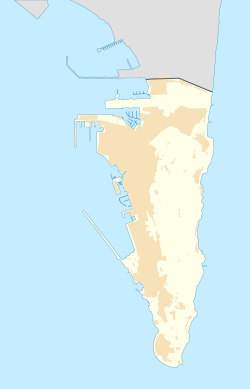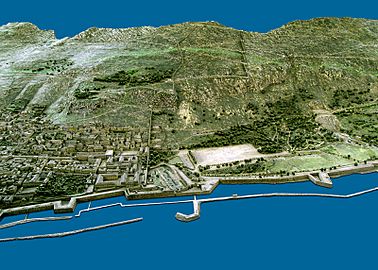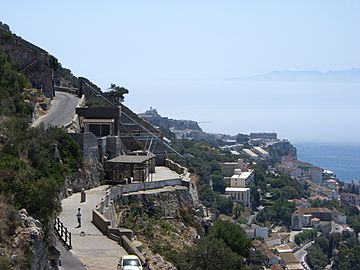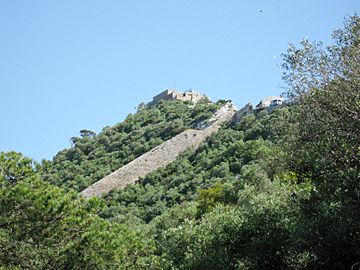Charles V Wall facts for kids
Quick facts for kids Charles V Wall |
|
|---|---|
| Part of Fortifications of Gibraltar | |
| Gibraltar | |
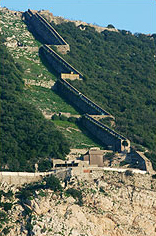
Upper section of Charles V Wall in the Upper Rock Nature Reserve, Gibraltar
|
|
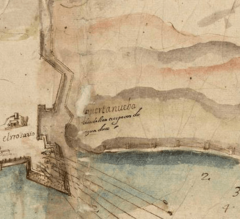
1608 plan of the lower portion of the wall, showing lines of fire from the South Bastion, by Cristóbal de Rojas
|
|
| Coordinates | 36°07′56″N 5°20′54″W / 36.132143°N 5.348293°W |
| Site information | |
| Owner | Government of Gibraltar |
| Open to the public |
Yes |
| Site history | |
| Built | 1540 |
| Built by | Emperor Charles V |
The Charles V Wall is an old defensive wall in Gibraltar. It was built in the 1500s to help protect the area. This wall is still mostly standing today. It stretches from the South Bastion, which was once right by the water, all the way up to the top of the Rock of Gibraltar. It was first called Muralla de San Benito, meaning "St. Benedict's Wall". Holy Roman Emperor Charles V had it built in 1540 and made stronger in 1552.
Contents
What is the Charles V Wall Like?
The wall has two main parts: a lower section and an upper section.
Lower Section of the Wall
The lower part of the wall starts at the South Bastion. This bastion used to be right at the edge of the harbour. The wall then goes up to Prince Edward's Gate, which is at the bottom of a steep cliff. There's a special opening in this part of the wall called the Puerta de África (which means "Gate of Africa"). The Flat Bastion is positioned above this gate to protect it.
Upper Section of the Wall
The upper part of the Charles V Wall is a bit further south. It climbs from the top of a cliff right up to the very top of the Rock. This section of the wall is built in a zigzag shape. This design was clever because it allowed defenders to shoot at attackers from the sides, making it harder for enemies to get close. At the very top of the wall, there used to be a small tower at a spot called the Hacho, which is now known as the Signal Station.
Another wall, called the Moorish Wall, continues from the lower Charles V Wall almost to the top of the Rock. People once thought it was built by the ancient Moors. However, it was actually built in the 1500s by King Philip II of Spain. It was meant to be a backup defense line.
How Was the Wall Built?
When the Charles V Wall was being built, the biggest danger to Gibraltar came from pirates. These pirates were known as Barbary pirates. In 1540, a group of pirates attacked Gibraltar. They stole many things and captured important citizens. So, the wall was built that same year to help protect the Rock from future attacks from the south.
Around 1552, an Italian military engineer named Giovanni Battista Calvi started making the wall better. He planned a wall that went straight from the coast for about 280 meters until it reached a steep drop. Then, a zigzag wall was planned to go up to the top of the Rock.
Later, King Philip II took over from Charles V in 1558. He hired another engineer, Giovan Giacomo Paleari Fratino, to keep working on the wall. Fratino had different ideas. He wanted to change Calvi's zigzag design. However, another chief engineer, Tibúrcio Spanucchi, insisted on finishing the zigzag wall. This zigzag part was finally completed in 1599 and is what we see as the upper section of the Charles V Wall today.
By 1627, two important strongholds, the Baluarte de Nuestra Señora del Rosario (now South Bastion) and the Bastión de Santiago (now Flat Bastion), had been built in the lower part of the wall.
In 1627, a Spanish writer named Luis Bravo de Acuña wrote about Gibraltar's defenses. He mentioned how defenders could roll large rocks down on attackers. They also had special platforms above the city gates to drop big stones on enemies below.
History of the Wall
In 1704, forces from the United Kingdom and the Dutch Republic captured Gibraltar. Later that year, the Spanish tried to take it back. During this time, a group of 500 volunteers, led by a local goatherd named Simón Susarte, managed to climb the Charles V Wall. They surprised the guards at Middle Hill. However, they were then attacked by soldiers and were all either killed or captured.
The Southport Gates were built where the old "Gate of Africa" used to be in the lower wall. Near these gates, there used to be a cemetery called Deadman's Cemetery. Some of the gravestones there were from as far back as 1738. In 1798, another small cemetery, Trafalgar Cemetery, was opened on the other side of the wall. Many people buried there were victims of yellow fever outbreaks in the early 1800s. In 1932, the old gravestones from Deadman's Cemetery were moved to Trafalgar Cemetery.
The upper part of the Charles V Wall has been recently fixed up by the Bonita Trust and the Government of Gibraltar. The wall is in good shape and has a handrail. You can even walk along it from the bottom to the top of the Rock! This upper section is part of the Upper Rock Nature Reserve, a protected area that covers about 40% of Gibraltar. A walking path called Inglis Way starts near the wall and goes through areas with interesting plants like esparto grass and wild asparagus.
Gallery
See also
 In Spanish: Muralla de Carlos V (Gibraltar) para niños
In Spanish: Muralla de Carlos V (Gibraltar) para niños


